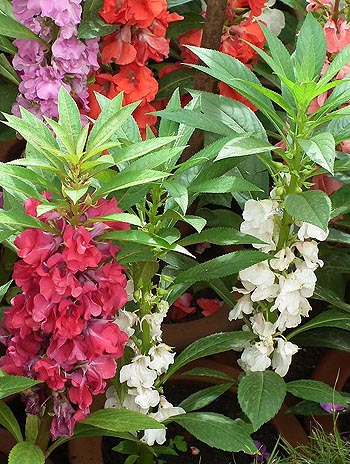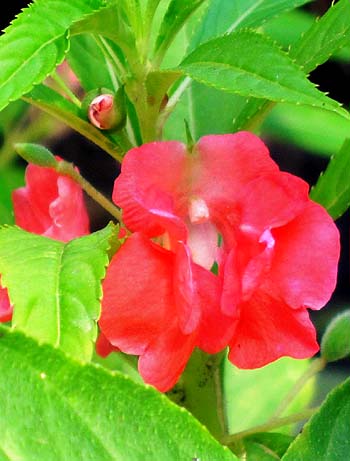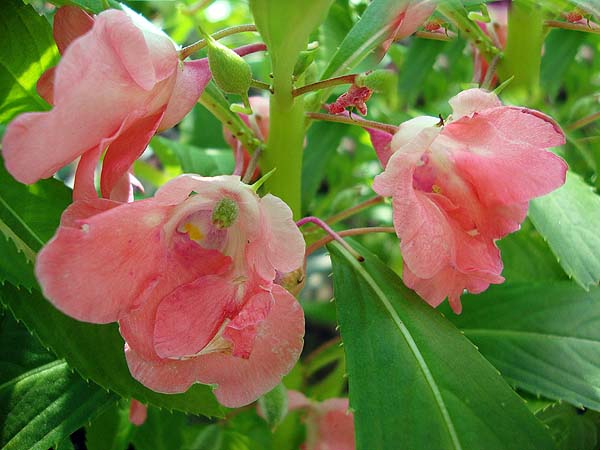A truly lovely annual plant for sun to partial shade depending on your location. It begins to flower at about 3" (7.6 cm) tall and does not stop until the frost kills it in late fall. Its very showy with a wide range of colors on straight stems. It is loved by hummingbirds, butterflies and other pollinators. Can easily be grown in containers to brighten patios and decks. Needs very little maintenance once established for a whole season of color. Its also entirely edible when cooked it tastes like asparagus. Unfortunately the deer and rabbits think so too.
Description of Garden Balsam (Impatiens balsamina).
It's an impatiens but instead of branching it forms one tall spike of flowers.
Like other impatiens it's a delicate annual which is very susceptible to frost.
However it will also do well in more sunshine than regular impatiens (Impatiens
walleriana, a.k.a. Impatiens sultani). The topknot variety are a dwarf version
so the spikes reach about 2' (61 cm) in height. The stems are thick and fleshy
with light green broadly lanceolate leaves 1.5 to 6"(3.8 - 15.25 cm) long,
the apex tapering to a point, deeply serrate to sometimes lobed. Leaves are
arranged in gentle though not always obvious spiral up the stem with flowers
appearing from the base of each leaf in profusion. Flowers are 1-2" (2.5
- 5.0 cm) across with open cone shaped flowers and come in a wide variety of
colors mostly from white, pink, red, salmon, lilac and violet. Flowers are followed
by long thin seed capsule that will explode on touch. Flowers are loved by hummingbirds,
butterflies and many other pollinators. Flowers are prolific the plants begins
flowering when only a few inches tall and will continue until the frost kills
it in late fall. Deer and rabbits also like them.
Growing Garden Balsam (Impatiens balsamina) from Seed.
Balsam is an easy plant to grow from seed provided you remember not to cover
it. The seeds need light to germinate.
Indoors.
Start seeds about 6-8 weeks before last frost for largest plants. Grow in small
pots or seed trays spacing the seeds thinly on good potting soil. Press down
with light pressure after seeding to ensure good soil contact with the seed
but do not cover they need light to germinate. Make sure that the overnight
temperature does not fall below 55°F (13 °C). Keep soil moist not wet
with a temperature between 70 -75 °F ( 21-23°C). Seeds should germinate
in 7 -15 days but can take longer if temperatures are lower. Pot on and grow
to about 2-3" (5.0-7.6 cm) tall before planting out. For detailed instructions
on growing seeds see our general
growing instructions.
Balsam is very sensitive to cold so take care not to place outside too soon.
If hardening off and weather gets cold bring the plants back inside.
Direct Seeding.
Seeds can be planted directly outside after all danger of front has passed.
Clear the area and space seeds about 12" (30.5 cm) apart press down to
ensure good soil contact but do not cover seeds they need light to germinate.
Keep moist not allowing the soil to dry out until the seedlings germinate and
grow. Thin if necessary.
Location and Care of Garden Balsam (Impatiens balsamina).
Soil. Balsam is pretty happy in almost any soil type. However
it will do best if there is a good amount of organic material in the soil. So
adding some well rotted compost or other amendment before planting is recommended.
Will grow well even in heavy clay soils. Soil must be moist at all times but
not wet. While Balsam will tolerate any soil type it does need more water than
most. The stems are very fleshy and only stand upright with good water turgor
which makes the stems stiff. Adding compost to the soil will help keep the soil
moist, or help heavy soils drain a little so not too wet. Don't let soil dry
out for any significant period or the plants will droop.
While it likes moist soil it does not like boggy conditions the roots will rot
and kill the plant.
Watering. Balsam will need a good supply of water to keep the soil moist but not soggy. Do not plant in wet areas. Winding a soaker hose through a bed of balsam is an ideal way of keeping them moist. Watering from the base helps prevent powdery mildew.
Light. This is going to depend on where you are located. In cooler zones 6 and above full sun is suitable. For zone 7 some shade from the noonday sun is suggested and 8 and above should plant in partial shade with morning or afternoon sunshine only. The nice thing about Balsam is that is it versatile and will tolerate more light conditions than Impatiens walleriana.
Separation. Grow 1-2 feet (30-61 cm) apart. Allow good airflow around the plants and through the leaves. This will help reduce moisture buildup which can encourage powdery mildew.
Tolerates humid heat. Once established, Balsam will grow well and bloom continuously well into fall. Annual varieties are susceptible to frost.
Problems with Impatiens.
In recent years growing Impatiens in home gardens has been much more of a challenge
due to the invasion of mildew. The plants were virtually eaten out of the ground.
Sadly once the spores are in the ground its almost impossible to grow impatiens
in that spot again for many years. The good news with Balsam is that it needs
different conditions from Impatiens walleriana which was grown mostly as a shade
annual. Sadly that is no longer possible but Balsam will tolerate more sun so
can be grown in areas where the regular impatiens did not and so the soil should
not hold the deadly spores.
Dealing with late frost.
So you put your impatiens plants (any kind) into the ground and they are doing
fine, then a late frost is announced. If you leave them they will die they are
very susceptible to frost. What do you do?
Make sure you always keep a good supply of disposable plastic shopping bags
on hand. Take these and go out and place one over every plant, or group of plants
if you can fit them. Weigh down with stones to ensure that they don't blow away
in any light breeze. Make sure you get all the plants. Your yard will look a
little odd but the bags will work like mini greenhouses and keep the frost off
the plants. Next day when frost is past the bags can be removed. Check the weather
before removing bags to ensure no more frost is forecast. Plants can remain
in bags for several days without harm if needed.
Culinary Uses of Garden Balsam (Impatiens balsamina).
Plant is entirely edible both leaves and stems and can be cooked an eaten as
a vegetable tasting rather like asparagus. Seeds are collected and cooked as
well but since they are small this is extremely time consuming. Some sources
state that eating large quantities of this plant may be dangerous due to high
mineral content. However the plant does not contain a large amount of minerals
but it may have calcium oxalate also found in rhubarb. It is harmful raw but
is destroyed in cooking. However People with a tendency to rheumatism, arthritis,
gout, kidney stones and hyperacidity should take especially cautious if including
this plant in their diet.
Medical uses of Garden Balsam (Impatiens balsamina).
Plant is emetic, cathartic and diuretic. It is used to treat painful joints.
Most commonly the juice from the leaf is used for various maladies including
painful joints, warts, burns and scalds. A juice made from the flowers is used
as treatment for snakebites as they area cooling tonic. An alcoholic extract
of the flowers has very high antibiotic activity against some pathogenic fungi
and bacteria. The seed is expectorant and has been used in the treatment of
cancer. The powdered seeds are given to women during difficult labour to provide
strength.
Other uses
A dye is obtained from the flowers and leaves which has been used for dyeing
finger and toenails red.
Other useful info.
Plant is originally from India
where it gets is love of heat and humidity.
The common names of Touch me Not and Jumping Betty are derived from the way
the seed pods explode when touched. This habit will often provide new plants
for the following year.
Other names.
Pop Weed, Bang seed, Touch me Nots, Balsamine, Jumping Betty, Garden Balsam,
Rose Balsam, Garden Touch-Me-Not, Lady's Slipper, Beijo de Frade, Fen Hsien,
Hosen-ka, Ji Xing Zi, Kina Cicegi, Snapweed, Spotted Snapweed.









